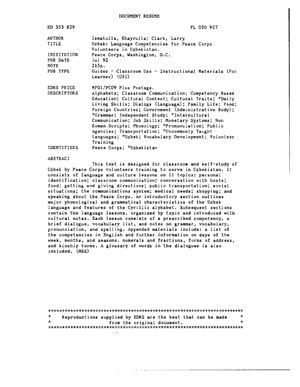Washington, D.C. : Peace Corps, 1992. - 215p.
This text is designed for classroom and self-study of Uzbek by Peace Corps volunteers training to serve in Uzbekistan. It consists of language and culture lessons on 11 topics: personal identification; classroom communication; conversation with hosts; food; getting and giving directions; public transportation; social situations; the communications system; medical needs; shopping; and speaking about the Peace Corps. An introductory section outlines major phonological and grammatical characteristics of the Uzbek language and features of the Cyrillic alphabet. Subsequent sections contain the language lessons, organized by topic and introduced with cultural notes. Each lesson consists of a prescribed competency, a brief dialogue, vocabulary list, and notes on grammar, vocabulary, pronunciation, and spelling. Appended materials include: a list of the competencies in English and further information on days of the week, months, and seasons, numerals and fractions, forms of address, and kinship terms. A glossary of words in the dialogues is also included. (MSE)
This text is designed for classroom and self-study of Uzbek by Peace Corps volunteers training to serve in Uzbekistan. It consists of language and culture lessons on 11 topics: personal identification; classroom communication; conversation with hosts; food; getting and giving directions; public transportation; social situations; the communications system; medical needs; shopping; and speaking about the Peace Corps. An introductory section outlines major phonological and grammatical characteristics of the Uzbek language and features of the Cyrillic alphabet. Subsequent sections contain the language lessons, organized by topic and introduced with cultural notes. Each lesson consists of a prescribed competency, a brief dialogue, vocabulary list, and notes on grammar, vocabulary, pronunciation, and spelling. Appended materials include: a list of the competencies in English and further information on days of the week, months, and seasons, numerals and fractions, forms of address, and kinship terms. A glossary of words in the dialogues is also included. (MSE)

